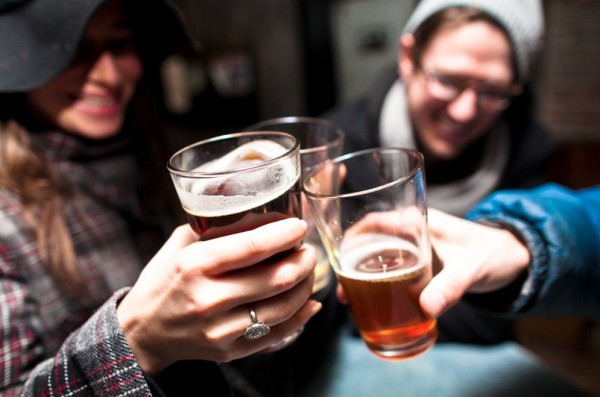
Revelers toast at One Stop Beer Shop. Photo by Benjamin Lozovsky
The baby boomers had their revolution—civil rights, women’s rights, anti-war, anti-poverty—and now their children are having their own: the craft beer revolution. Thank God, because for a while there, everybody was worried that kids born after 1975 were becoming permanent slackers.
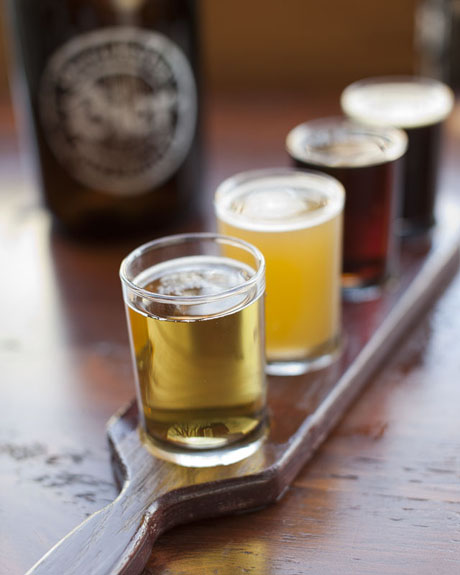
Beer taster at Bier Merchants. Photo by Benjamin Spell
When the wine-loving food critic Alan Richman released his list of ten favorite craft beers in GQ recently, we knew that the craft beer revolution had arrived. Clearly, beer is not just for blue collar workers, college students, football fans, and wife beaters anymore. Much like premium coffee, its marketing has taken on the language of wine culture. At stylish bars, you can get a flight of beer, order beer cocktails, or learn how to pair fancy food with fancy beer. It’s even okay to drink beer while appreciating fine art. Red Hook’s Sixpoint Craft Ales recently teamed up with the Museum of Modern Art to create a stein beer worthy of MoMA’s pricey restaurant, where art lovers dine.
Overall, U.S. beer sales have been flat for the last two years, while the sale of craft beer has risen a whopping 11%. Now before you get all beergasmic, keep in mind that craft beer only represents about 10.3% (in dollars) of the total U.S. market, while the big three beer giants (Anheuser-Busch, Molson Coors, and SAB Miller) still hold 79% of market share. The other 9.7% is claimed by imports. But an 11% gain in sales is still damn impressive, proof that the craft beer movement has legs. At last count, there were over 1,900 breweries in the U.S., a huge leap from 80 in the 1980s, but still far short of the 4,000 plus breweries that existed in the boozy 1860s. Back then, anyone who had a bathtub made beer. But 13 years of Prohibition (1920 to 1933) put a stop to all that.
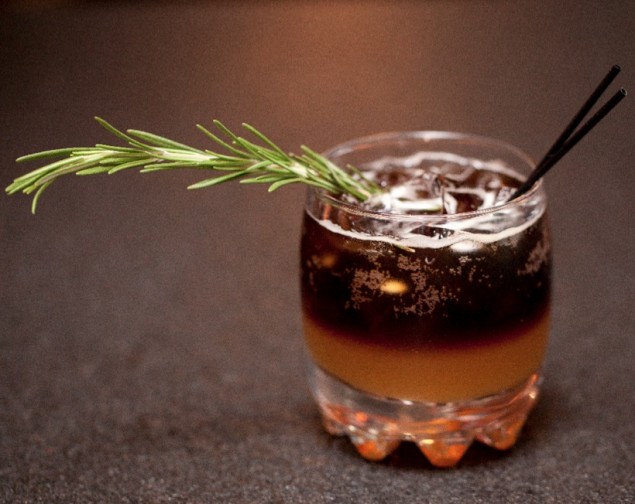
One Stop “Dark and Smoky” a Porter beer and moonshine cocktail. Photo by Benjamin Lozovsky
Now beer is back! Blame it on the internet, ubiquitous food shows, or the lousy economy. Young people who once would have been snapped up by banks, advertising agencies, law firms, magazines, or Wall Street are now lazing around their parents’ basements looking for stuff to do. Some are taking up cupcake baking, some are up-cycling old rags, some are dreaming up new reality shows (Hipster Housewives?), some are hacking into Facebook or Pentagon websites, but the smart ones are making beer. Modern day brewers can also thank President Jimmy Carter, who signed the bill legalizing home brewing in 1979, dismantling one of the last vestiges of Prohibition. Carter must have foreseen that someday there would be a “lost jobs” generation that needed to make beer for a living. After all, Carter had a less accomplished brother, Billy, who once was paid to be a spokesman for Billy Beer (Falls City Brewing Company). It was all very cute until Billy was caught on camera relieving himself in public while Jimmy was still in office.
What is Craft Beer?
Shortly after home brewing was legalized, beer lovers started experimenting with kits and hops. Soon, those with an entrepreneurial spirit got their product into local pubs and restaurants. Because they were making small batches, they could afford to use high-quality ingredients and not water down their brew with corn or rice products like the majors. As a result, their beer had more robust flavors. You know how it is: youth with pent up creative energy fueled by fizzy alcoholic lubricants opening Pandora’s Box. Beer makers today are America’s new mad scientists, throwing every kind of herb, fruit, gourd, chili, chocolate, and even lava rock, into the mix.
Our European cousins are shaking their heads and rolling their eyes at the audacity of messing with something as traditional as beer. In Germany, many brewers still adhere to the centuries-old beer purity law “Reinheitsgebot,” which frowns on exotic ingredients. Although some aspects of the law have been repealed, brewers are still doing stuff the classical way. According to Renee, one of the owners of Breukelen Bier Merchants, on Grand Street, when European tourists visit, they want to buy American craft beer. “They want to taste the local stuff,” she says.
In fact, some American craft beers are making inroads into an entrenched Europe. According to the Guardian, Sierra Nevada‘s Pale Ale, Goose Island’s beers, and Brooklyn Lager can now be found in British supermarkets. Some experts credit the American craft beer movement with turning around the reputation of America’s beers. Others point to the marketing brilliance of these creative breweries. Cool graphics and catchy names attract young drinkers. Who can resist monikers like Noble Rot, Bitches Brew, He’Brew, Ruination IPA, Old Engine Oil, In Heat Wheat Beer, and Irish Death?
Beer Central
While Portland, Oregon, is the epicenter of American craft beer, Williamsburg and Greenpoint are craft beer central in New York. There is literally a bar on every corner, and even dive bars serve an impressive array of craft beers. Williamsburg was once home to Dutch and German brew masters, so it’s only fitting that an East Coast revival should have North Brooklyn as its center.
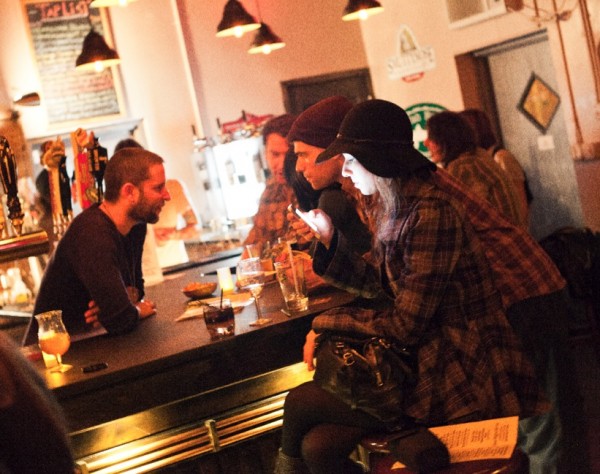
At One Stop. Photo by Benjamin Lozovsky
Spuyten Duyvil, on Metropolitan Avenue, was an early innovator and is considered by beer geeks to be the local “Temple of Craft Beer.” “That’s because we go out of our way to find unique beers, which we’ve been doing since we opened ten years ago,” says bartender Alex. On the day I visited, the focus was on the Maryland artisan brewery Stillwater. Its Debutante farmhouse ale is on Richman’s top ten list. On tap were Kuhnhenn Prometheus, Mikkeller Blackhole Stout (aged in whiskey barrels), Otter Creek Anniversary Ale, Reissdorf Kolsch, and Harviestoun Bitter & Twisted (served from a cask). Alex also likes Germany’s Bamberger Mahr’s unfiltered lager in a bottle. “Bamberger is one of the best breweries in the world,” he says. We ordered a bottle and loved it. It was crisp, smooth, and well balanced. Foodies will also find this a great place to sample artisan cheeses, cured meats, and pickles.
Another bar that stocks a lot of craft beer is d.b.a., on North 7th Street near Bedford Avenue. d.b.a.’s older sister, d.b.a. Manhattan is considered the first craft beer bar in New York City. “Back in 1994, you really had to go out of your way to find good craft beer,” says Al, d.b.a.’s bartender. The Brooklyn branch opened three years ago and stocks over 200 bottles from all over the world, including the celebrated Jolly Pumpkin collection. There are about 16 beers on tap and three cask brews. I enjoyed the Winter Lager, with a hint of chocolate, from Kelso Brewery. “We’re known for our cask beers,” says Al. “We have a cask festival in March, after St. Patrick’s Day.” Al talked about a cask from the newly formed Bronx Brewery. “It’s actually brewed in the Bronx and tastes pretty good. People want to know what the Bronx is up to,” he says. The Bronx Brewery somehow managed to convince a local Catholic church to allow them to grow some hops on church ground so they could develop a beer using wet hops. And why not? Monks have been brewing beer for centuries.
In Greenpoint, one of the newest bars specializing in craft beer is One Stop Beer Shop on Kingsland, where you’ll find the next trendy thing—beer cocktails. In addition to having 16 tap beers, bartender Pamela recommends the Orange You Glad? A cocktail for beginners. It’s made with Original Moonshine, orange juice, agave, muddled orange, and lemon, and topped with Brooklyn Brewery’s BK Sorachi Ace. (BK Sorachi Ace is also on Richman’s top ten list.) “My boss, Ben, spent a lot of time searching for unique ingredients for the cocktails,” she says. Pamela’s favorite beer on tap is La Chouff, a golden blonde ale from Belgium’s Achouffe Brewery, and Founder Centennial IPA from Michigan. One Stop Beer Shop also has a growler delivery service.
Another well-regarded craft beer shop is Brouwerij Lane, on Greenpoint Avenue. They’re known for expert bartenders who are happy to let you sample the beer before ordering, and they often host artisanal beer events like Imperial Stout weekends. There’s a backyard, a wood burning furnace, and 19 exotic beers on tap. What more do you need?
Most bartenders who specialize in craft beer are very patient. “Let us know what style of beer you’re looking for and we can work with you,” says Al at d.b.a. That means, “Don’t just say I want to try a light beer,” rather describe the kind of beer you enjoy, whether it’s stout, IPA, sour, local, gluten-free, German, or Bud Lite.
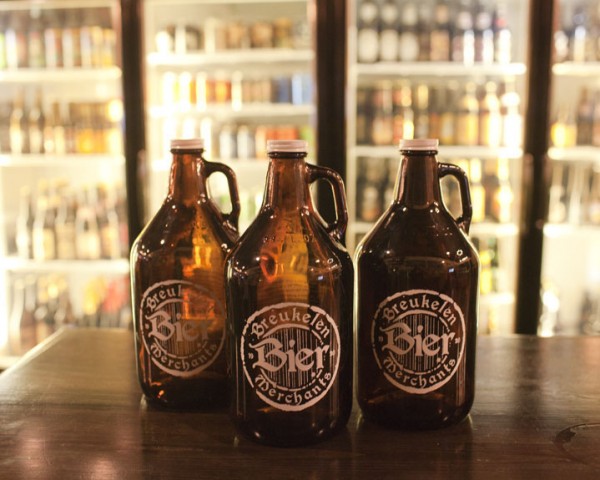
Bier Merchants growler jugs. Photo by Benjamin Spell
Beer shops that serve food are also a wonderful place to learn about beer. At Breukelen Bier Merchants, on Grand Street, they stock over 500 bottled beers and usually have about 16 beers on tap. The three owners—Denise, Renee, and Greg—are craft beer experts and are there to help you with new selections. The atmosphere is usually a bit calmer than your typical bar, and you can get sandwiches or beer snacks and hang out at the communal tables. Breukelen Bier Merchants offers growler services and cheese-and-beer pairing events. On tap recently were Sixpoint Gorilla Warfare, Wondering Star Thunderbolt, Saranac white IPA, and Southhampton Diere de Mars. Renee says the most interesting bottle beer she has in stock is the very rare, Polish-style smoked beer, Piwogradziskie, made by a German brewery. “It’s very interesting, a little sour, a bit smoky.”
On Franklin Avenue, there’s The Diamond, a bar with a well-chosen micro beer list. It has a relaxing patio and free shuffleboard, and you can dine on cheese and meat plates. They have special events like ladies’ arm wrestling and pre skiing parties. Apparently, somebody there organizes ski trips.
Back on Bedford, check out Lucky Dog, a dog friendly beer bar. They’ve got a patio, 20 beers on tap from famous breweries, plenty of bottled beers, and a cask engine. You’ll see all the favorites: Dogfish Head, Ommegany, Troegs, and Reissdorf. There’s also shuffleboard and a doggie treat dispenser, and you’re welcome to bring your own grub.
At Gordon Bennet, an old world Irish pub and grub on South 6th Street, we decided to let bartender Margaret choose a tap beer for us. She picked Kostritzer Schwarzbier, a black beer from Germany. We also ordered a chocolate bread pudding as a bar snack, and amazingly, the two went together like Brad and Angelina. This is a nice low-key bar where you can catch up with your friends while grabbing a bite to eat.
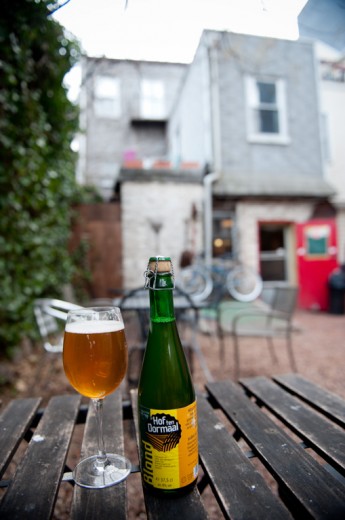
A favorite import at Spuyten Duyvil. Photo by Allen Ying
Pubs as Adult Amusement Parks
What makes visiting North Brooklyn beer pubs so thrilling is that they all have different themes, decors, and cultures. There are metal bars, dive bars, punk bars, gay bars, geek bars, and friendly neighborhood bars. There are authentic and family friendly biergartens (Radegast Hall & Biergarten), or handsome bars, like the one with a Bauhaus interior and an outdoor biergarten (Loreley). There are bars with bowling (Brooklyn Bowl, The Gutter), bars with arcade games (Barcade), dog friendly bars (Lucky Dog, d.b.a, Mark Bar), and dive bars with well-priced craft beer (Mugs Ale House). And then there is that bar with the house-made beer, including a black Chocolate Stout and Maple beer (Brooklyn Brewery). There’s also a hall with 6,000 sq. ft. and a steampunk interior (Spritzenhaus). But that is nothing compared to the mind blowing hall being built in Bushwick. Well Beergarten on Melrose, will be the largest in the city at 4,000 sq. ft. indoors and 11,00 sq. ft outdoors.
The craft beer movement fits right into the locavore ethos of the new millennium. It’s a way to support local craftspeople and is so much a part of the local economy that our Assemblyman, Joseph Lentol, sponsored a bill back in 2005 to promote and create a New York Beer Trail that brings beer loving tourists from around the world to the Empire State. It has been estimated that the craft beer industry has created over 100,000 jobs for New York State alone. Let’s drink to that.
—eatingaroundmy@gmail.com
Leave a Reply